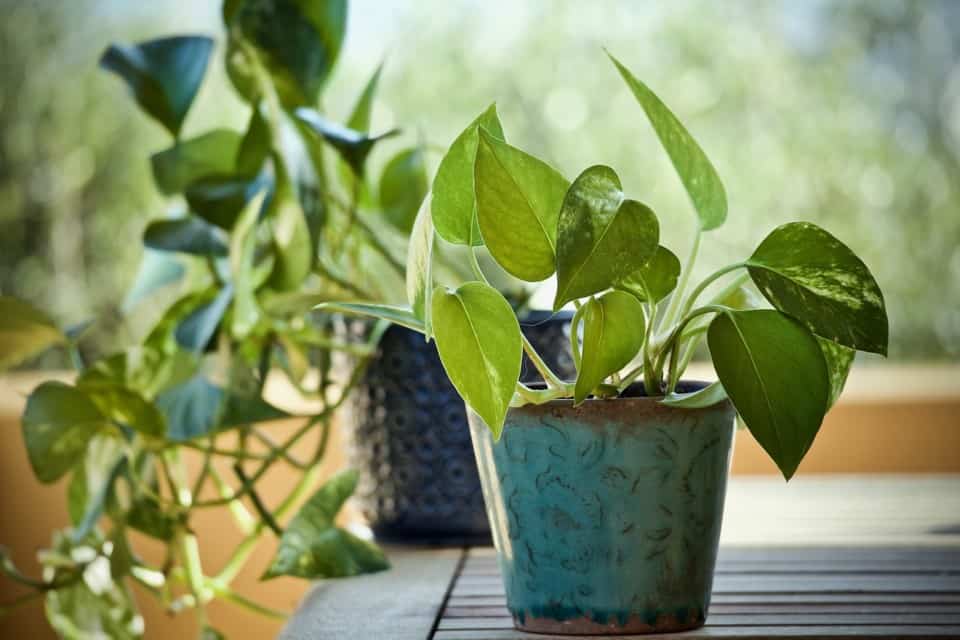Some links in the post are affiliate links and I get a commission from purchases made through some links found in the post.
While toxic when ingested, Pothos have become quite popular over the years. You find them in homes, offices, restaurants, and any other spaces that need a bit of sprucing up.
So, why are they such good choices? Well, they are quite low maintenance. Even beginners can hack the needs of these plants.
If you give them enough water, provide them with adequate humidity, and shield them from extreme temperatures, they can thrive. Oh, and they only need watering just once a week in most cases.
Doesn’t that seem like an easy task? Of course, you would expect that such a low-maintenance plant would do well in the outdoors too. But is that the case? Let’s find out:
Can Pothos Live Outside?
Are you hoping to plant your Pothos outside? This plant is native to the Solomon Islands, where it grows as tall as 40 feet!
A pothos can live outside in USDA plant hardiness zones 10-12 and prefers bright indirect light. A pothos likes well draining soil and to be watered regularly with high humidity and temperatures ranging between 70- 90°F.
But can you expect it to do quite as well in your region?
The USA
 The Pothos does well in USDA zones 10 to 12. Under these conditions, the Pothos can live outside all year round.
The Pothos does well in USDA zones 10 to 12. Under these conditions, the Pothos can live outside all year round.
But if you do not live in these regions, you would have to grow the plant indoors in the colder months. And in the warmer months, you can take it outside.
So, what are these hardiness zones? These are planting zones based on how cold or hot an area is, considering the average minimum winter temperature.
Zone 1 is the coldest, while zone 13 is the hottest. By that, you may have already guessed that the Pothos prefers hot areas.
Zones 10 to 12 include regions like Hawaii, Southern Florida, Southern inland California, the Florida Keys, and Puerto Rico. So, you can see that this coverage limits the number of people who can grow the Pothos outside.
The United Kingdom
Are things any different in the UK? The hardiness zones in the UK mainly lie between USDA hardiness zones 6 and 9.
In most of these regions, the summers are warm while the winters are quite cool. (Please note that the UK also uses the RHS scale, which runs from H1 to H7. But for this guide, we will use the USDA scale to unify the comparisons).
However, some exceptions lie in zones 10 to 12. These include Bryher, Isles of Scilly, Eastbourne, and Newham.
Once again, just like in the U.S., this coverage limits the number of people who can grow the Pothos outside all year. You would need to bring the plant in when the weather gets chilly.
What Does the Pothos Need to Live Outside?
As earlier mentioned, the Pothos is a low-maintenance plant. However, when moving it outdoors, you must ensure that it gets:
Enough Light
The plant prefers bright but indirect light. So, you should position it in a way that it gets enough filtered light, e.g., under a tree or among other plants.
If the plant does not get enough light, you will notice its growth is stunted. Also, variegated Pothos lose their patterns in low-light conditions.
Even so, you must be careful with the light exposure – too much of it can damage the plant. If you notice any paling in the leaves, that’s a sign that the plant gets too much sun.
Well-Draining Soil
On the bright side, the Pothos is not highly selective regarding pH. But it’s unforgiving of poor potting mixes.
You must ensure the plant grows in well-draining soil. And if you plant the Pothos in the ground, ensure you amend it to allow for enough drainage.
Regular Watering
The Pothos can do with water just once a week. The rule of thumb is to ensure its soil is completely dry before watering it again.
If not, root rot can ensue. So, space out the waterings, and when in doubt, invest in a moisture gauge. That will help you avoid underwatering the plant, which can also harm it.
High Temperatures
You should always aim for temperatures above 50 °F. Ideally, the temperatures should be much higher than this, averaging about 70 °F. After all, it’s a tropical plant and will respond kindly to such conditions.
High Humidity
Humidity should not be much of an issue. Even if it’s quite low, the Pothos will still survive. But it would do better if the humidity was high.
Regular Fertilization
Given that this plant feeds heavily, add fertilizer to its potting mix at least once a month.
Do your outdoors favor these growing conditions? If yes, you can comfortably grow a Pothos outside.
If you are enjoying this article, check out our article on a pothos vs a monstera.
How To Grow A Pothos Outside
Before growing a Pothos outside, you must consider your hardiness zone. It determines whether the Pothos can remain outdoors all year.
That way, if the plant needs to be indoors in the winter, you have no option but to pot it. Otherwise, in suitable regions, you can plant it in the ground all year.
So, how do you grow a Pothos outside?
Select a Variety of Pothos to Grow
 Pothos come in different varieties. These include Neon Pothos, Silver Pothos, Golden Pothos, and Marble Queens.
Pothos come in different varieties. These include Neon Pothos, Silver Pothos, Golden Pothos, and Marble Queens.
While their growing needs are quite similar, you must understand what the species you want to grow will need.
Also, when picking a plant, choose one with firm and green leaves and stems. Ensure the root base is firm, the leaves are healthy, and the soil is free of mold.
Most plants go into a bit of shock when transplanted. And you want to ensure that your choice of plant is healthy enough to withstand the new environment.
Choose a Container to House Your Pothos
In some cases, you may choose to go with the original Pothos container. If the plant does not show any signs of being rootbound, this can work.
But if you want another pot (because the plant is rootbound or for aesthetic reasons), get one. Ensure that the pot is well-draining and large enough to hold the Pothos.
Transfer the Pothos
Repotting the Pothos is quite an easy task. Start by filling the new pot with a potting mix to a quarter of its depth.
Then turn the original pot on its side and gently nudge the Pothos from the soil. Do not disturb its roots.
Place the plant in the new pot and add more potting soil to cover the roots. Leave at least two inches between the potting mix and the edge of the container.
Proceed to water the plant thoroughly such that water drains from the drainage holes. Then move the pot to an area where it can get enough light.
Keep in mind that the Pothos prefers bright and indirect light. So, please keep it away from shaded areas or those that receive direct sun.
That’s all it takes to grow the Pothos outside.
You may also like: Why do pothos leaves drip water
Pros And Cons of a Pothos Living Outside
What’s the better option between growing the Pothos outside or indoors? Let’s weigh the two:
The Advantages
The Pothos grows in tropical rainforests. Thus, you would expect that growing it outdoors would come with some benefits. Are you right?
1) Natural Light
It’s quite challenging to mimic the natural light you find outdoors when growing the plant indoors.
Sure, fluorescent lights sometimes suffice. But nothing beats that bright indirect light akin to that in the tropical forests. It helps the plant thrive.
2) Faster growth
The Pothos can grow as tall as 40 feet in the wild! But you cannot expect that indoors where the plant makes do with the little light it gets from the windows and light bulbs.
Thus, moving the plant outdoors is the way to grow its leaves and stem faster and healthier.
3) Reduced exposure to chemicals
What do you feed your plant with indoors? If you are like most people, you use tap water to water your Pothos. And while this water is safe for you, it hurts the plant.
Tap water is rich in chemicals like fluoride and chlorine. Over time, they build up in the soil, harming the plant. But outdoors, the plant receives pure, unfiltered rainwater that greatly benefits its growth.
4) More access to nutrients
Even if you regularly feed your Pothos with fertilizer, there is only so much you can do. Eventually, it uses up all those nutrients and its growth spurt decreases.
But it can soak up as many nutrients as it wants in the wild. Of course, this applies to Pothos grown in the ground and not in pots.
Do these pros encourage you to move your plant outdoors? Well, let’s consider why this might not be the best idea for your plant.
The Disadvantages
Moving the Pothos outside is not always the best way forward. Why is that?
1) Exposure to Temperature Changes
Indoors, you can often regulate the temperatures to which your Pothos is exposed. But outside, you do not control the winds and the sun.
As such, if you live outside hardiness zones 10 through to 12, there’s a chance the temperatures can dip and hurt your pothos.
2) Pest Infestations
You have much better control over your plant when it’s indoors. But outdoors, it grows amongst other vegetation that may harbor pests.
And it’s much harder to notice such an infestation in the wild. So, when it finally becomes apparent, it might have spread too far.
Those are the cons you must consider. Do you think you can work through them?
Can Pothos Stay Outside in Winter?
 Good question. Pothos generally do well in regions where the temperatures lie between 60 °F and 85 °F.
Good question. Pothos generally do well in regions where the temperatures lie between 60 °F and 85 °F.
If the temperatures fall below 50 °F, the plant can go into shock. And unfortunately, it might not survive the damage resulting from such a temperature dip.
So, can your Pothos survive the winter? It all comes down to how far the temperatures fall in your region.
If there’s a chance they could fall below 50 °F, do not attempt to leave the plant outside in the winter. Instead, move it indoors and wait until it’s spring.
Then you can move the plant back to the outdoors. And even then, you must be sure that the temperatures will not fall below 50 °F.
Final Thoughts
And before we forget, the Pothos has a unique carbon filter system. So, if you have any volatile chemicals threatening your health, this is a good way to eliminate them.
Just set the plant near a window or door and sit back and marvel at how clean the air feels afterward.
Happy Gardening!


